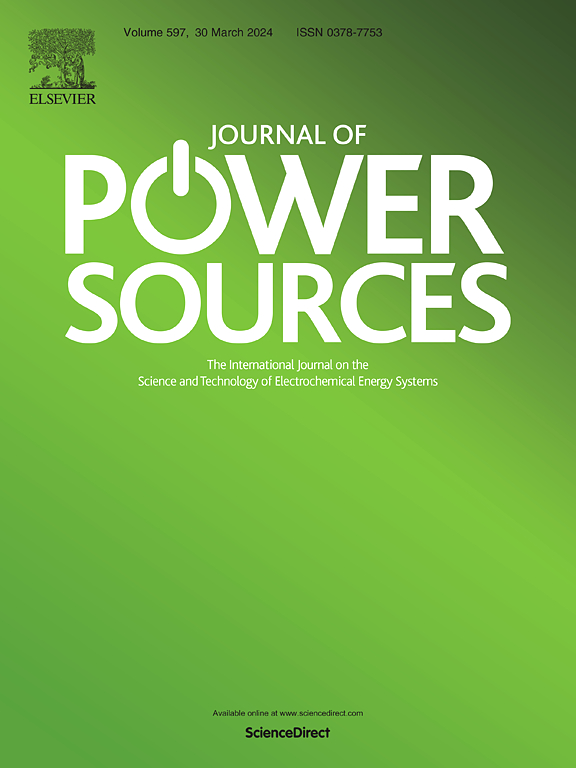Enhancement of K storage performance in K3V3-xLax(PO4)4/C cathode materials for potassium-ion batteries via La3+ gradient doping
IF 7.9
2区 工程技术
Q1 CHEMISTRY, PHYSICAL
引用次数: 0
Abstract
K3V3(PO4)4(KVP) is recognized as a promising cathode material for potassium-ion batteries (PIBs) due to its high capacity and robust cycling performance. However, its practical application is hindered by low electrical conductivity. This study reports on the synthesis of K3V3-xLax(PO4)4/C materials with varying levels of lanthanum doping, using sol-gel method. We conducted a systematic investigation into the effects of La3+ doping on the crystal structure, morphological characteristics, and electrochemical performance through physicochemical characterization, theoretical calculations, and electrochemical testing. Theoretical calculations suggest that La3+ doping reduces the band gap energy. Electrochemical tests demonstrate that appropriate levels of La3+ doping enhance the electrochemical performance of K3V3-xLax(PO4)4/C. Specifically, K3V2.98La0.02(PO4)4/C shows excellent electrochemical performance. After 100 cycles at 200 mA g−1, the discharge specific capacity reaches 59 mAh g−1, and after 300 cycles at 400 mA g−1, the reversible specific capacity maintains at 48 mAh g−1—nearly twice that of the undoped KVP/C. The enhanced electrochemical performance of these materials is attributed to La3+ doping, which appropriately enlarges the unit cell volume while stabilizing the crystal structure, improving K+ diffusion capability, and boosting the intrinsic electronic conductivity of the material. These findings offer new insights for developing cost-effective and high-performance cathode materials for PIBs.
通过 La3+ 梯度掺杂提高钾离子电池 K3V3-xLax(PO4)4/C 阴极材料的钾存储性能
K3V3(PO4)4(KVP)因其高容量和稳定的循环性能而被认为是一种很有前途的钾离子电池(PIB)正极材料。然而,低导电率阻碍了它的实际应用。本研究采用溶胶-凝胶法合成了不同镧掺杂水平的 K3V3-xLax(PO4)4/C 材料。我们通过物理化学表征、理论计算和电化学测试,系统研究了掺杂 La3+ 对晶体结构、形貌特征和电化学性能的影响。理论计算表明,掺杂 La3+ 会降低带隙能。电化学测试表明,适当水平的 La3+ 掺杂可提高 K3V3-xLax(PO4)4/C 的电化学性能。具体来说,K3V2.98La0.02(PO4)4/C 表现出了优异的电化学性能。在 200 mA g-1 下循环 100 次后,放电比容量达到 59 mAh g-1,在 400 mA g-1 下循环 300 次后,可逆比容量保持在 48 mAh g-1,几乎是未掺杂 KVP/C 的两倍。这些材料电化学性能的提高归功于 La3+ 的掺杂,La3+ 的掺杂在稳定晶体结构、改善 K+ 扩散能力和提高材料内在电子导电性的同时,适当地增大了单胞体积。这些发现为开发具有成本效益和高性能的 PIB 阴极材料提供了新的思路。
本文章由计算机程序翻译,如有差异,请以英文原文为准。
求助全文
约1分钟内获得全文
求助全文
来源期刊

Journal of Power Sources
工程技术-电化学
CiteScore
16.40
自引率
6.50%
发文量
1249
审稿时长
36 days
期刊介绍:
The Journal of Power Sources is a publication catering to researchers and technologists interested in various aspects of the science, technology, and applications of electrochemical power sources. It covers original research and reviews on primary and secondary batteries, fuel cells, supercapacitors, and photo-electrochemical cells.
Topics considered include the research, development and applications of nanomaterials and novel componentry for these devices. Examples of applications of these electrochemical power sources include:
• Portable electronics
• Electric and Hybrid Electric Vehicles
• Uninterruptible Power Supply (UPS) systems
• Storage of renewable energy
• Satellites and deep space probes
• Boats and ships, drones and aircrafts
• Wearable energy storage systems
 求助内容:
求助内容: 应助结果提醒方式:
应助结果提醒方式:


